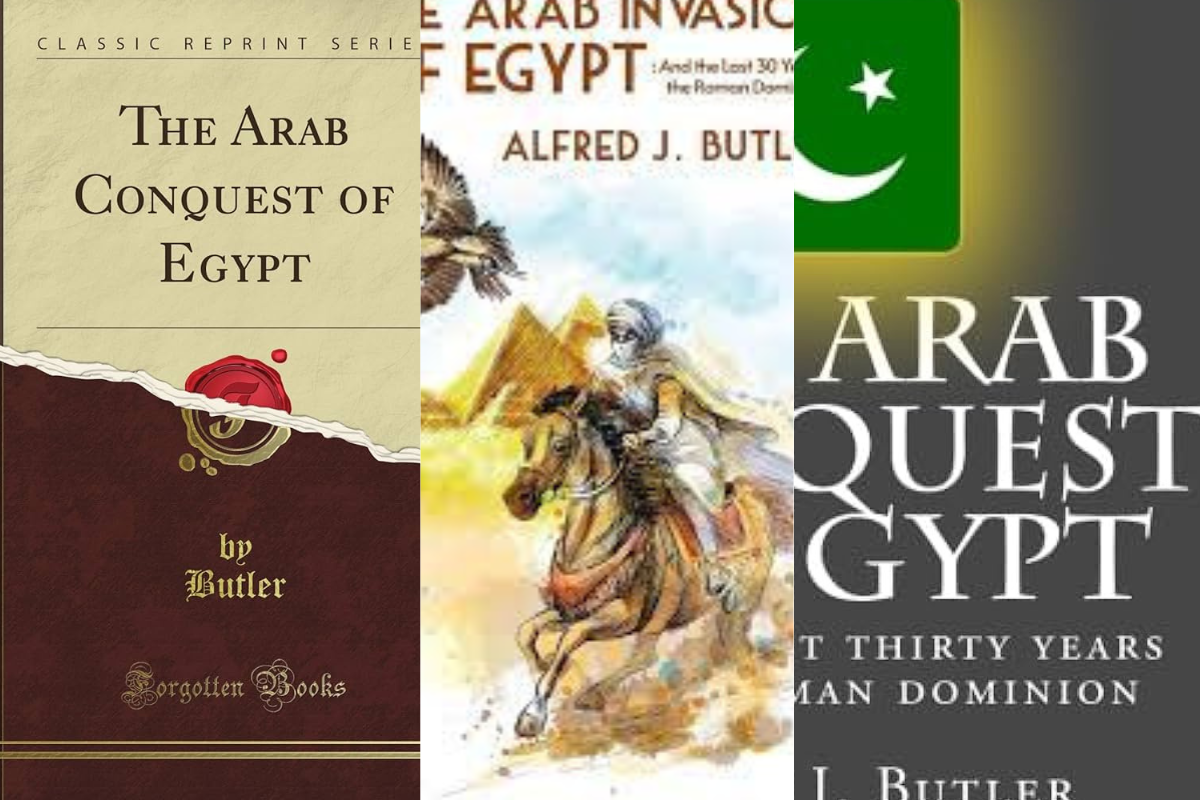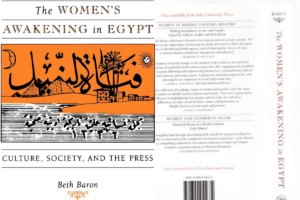The Arab Conquest of Egypt and the Last Thirty Years of the Roman Dominion. By Alfred J. Butler. Oxford: Clarendon Press; New York: Henry Frowde, 1902. 563 pages. $35.
The British historian Alfred J. Butler presents in this book, published in 1902, essential information about the entry of Muslims or Arabs into Egypt from different resources by both Arab and Roman historians. The importance of our book is not that it talks about the entry of Arab Muslims to Egypt only, but it carries many of the ingredients that make it the best book written about this period in the 20th century. We see Butler revealing many facts that were ambiguous and unclear in many Arabic and Coptic texts. In addition to the high culture that the author enjoyed in tracking the accuracy and validity of events and selecting the accurate texts he used. In addition to the scientific integrity and the methodology of his historical and academic research, which he followed.
The book included thirty chapters. The first five chapters deal with the conditions of Egypt during the reign of Emperor Phocas. Then Hercules’ departure and his war plan to eliminate his rivals. Then Heraclius ruled over Constantinople, and later Egypt became under his rule. The sixth and seventh chapters deal with the conquest of the Persians to the Levant and the conquest of the Persians to Egypt. The eighth chapter talks about the literature and the arts that Alexandria celebrated at that time.[1] The ninth and tenth chapters are concerned with the struggle of the Companions of the Cross against the pagan Persians until the victory of the Romans is accomplished. They celebrate the ascension of the Cross in the Church of the Holy Sepulcher. Then chapter eleven deals with the call of the Messenger Muhammad. Chapter twelve deals with the conquest of the Arabs to the Levant. The thirteenth chapter deals with the tremendous persecution of the Copts at the hands of Cyrus, then the march of the Arabs to Egypt. In this critical chapter, Butler addresses the tremendous persecution that the Copts encountered at the Melkite Roman Patriarch Qiris (Al-Mukaukas). This chapter is considered an introduction to the entry of Arabs into Egypt; we see the arbitrariness of this ruler, whom Butler described as a traitor and oppressor. In the following chapters, Butler deals with the Arab march to Egypt and the beginnings of the war. He discusses important issues such as entering Egypt was by peace or force. The first of the war, the story of Heliopolis and the fortress of Babylon, its siege and conquest, and the destruction of the Romans in the Copts of Egypt fatal. The author excelled in refuting this story with what other historians did not do with all these essential details. Butler talked about the Babylon Fortress and its military and religious importance, siege, how to open it, and how Amr Ibn Al-Aas continued the battles he fought to Alexandria. After that, Butler discussed the peace treaty that was concluded between Amr and Al- Mukaukas, a chapter on the incidents of Constantinople, the death of Hercules, who was rejecting the reconciliation that took place between Amr and Al- Mukaukas. In addition to the ending of the rule of the Romans in Egypt. The chapters from the twenty-fourth to the twenty-sixth showing Butler’s admiration for the city of Alexandria as the capital of the Romans in Egypt, explaining the beauty of its architecture and the fascination of the Arabs when they entered it. Butler devoted the entire twenty-fifth chapter to the Library of Alexandria. He rejected the idea that Omar bin Al-Aas was responsible for burning it with evidence that denies these suspicions and allegations. As for the last chapters, Butler deals with the return of Benjamin from his exile, the thirty-eighth Patriarch of the Church of Alexandria, after an absence of thirteen years of his escape from the oppression and persecution of the Romans. The return of Benjamin pleased the Copts, and this incident demonstrated the good intentions of the Arab Muslims towards the Copts.[2] Butler attached six appendices to this essential historical book: (1) on the relic called the holy rood, (2) on the chronology of the Persian conquest, (3) on the identity of Al- Mukaukas, (4) on the chronology of the Arab conquest, (5) on the age of Amr bin Al-Aas, and (6) on the dates of the Coptic patriarchs after Benjamin in the seventh century. These appendices are almost independent research by the author concerning the subject of his study. We see it also complementary to the subject of the book.
Butler’s book is different and unique in his account of the entry of the Arabs into Egypt. Because he wanted to pursue the truth, he did not have any political or religious goals in writing this book. He tried, and we see that he succeeded in showing the complete picture, which was not so clear before. What helped Butler accomplish this work is his dependence on the Arabic and Coptic resources written close to the event. He used some Arabic resources, such as the writings of Ibn Abd al-Hakim, and al-Tabari. And some Coptic writings such as John of Nikiû, Sa’id ibn al-Batriq, and Sawiris ibn al-Muqaffa. In addition to what was written by Western Orientalists such as the French geographer Emile Amelino and the English historian Stanley Paul. He used the methodology of narrative historical research with their multiple narratives by comparing the different narratives, which were very close to each other. He was investigating the sources of these narratives. Sometimes he came to criticize some novels and reject them altogether. Butler’s approach helped to link the texts of the book and the comparison between historical narratives and their accuracy. However, this does not prevent Butler’s tendency to favor some Coptic narratives against Arabic narratives and some Arabic narratives against Coptic narratives. Some criticized Butler for conclusions that came to confirm the author’s prior opinion or personal conviction regarding some ideas before citing the reasons. He was more inclined to the narratives of Coptic historians and neglected the conflicting accounts of Arab historians. We see that Butler’s position is more inclined to Coptic narratives because the Coptic historians are historically closest to those events. Some of them were contemporaries at the time of the Arabs’ entry into Egypt. Although Butler grew up in a religious family and his father was a pastor, we do not see that this made his bias to the Coptic narratives. Butler’s scientific methodology and his research components made him inclined to objectivity in one of the best works written about Egypt during this period that get the credit from the East and the West together.
Butler believed that the history of the Arab conquest of Egypt is a history surrounded by complete darkness because of the lack of narrators and sources, whether they are eastern or western. In addition to the widespread disagreement between these different accounts of the story. Butler cites in his book’s preface to argue about the mystery of the entry of Arabs to Egypt, with the opinion of a very well-known writer, E.W. Brooks, who says, “There is scarcely any important event in the history of which the accounts are so vague and so discrepant as the capture of Alexandria. The whole history of the irruption of the Saracens into the [Roman] empire is indeed dark and obscure: but of all the events of this dark period the conquest of Egypt is the darkest.” (P. xiii) Butler tries to remove ambiguity about this critical historical period by reaching the truth with all objectivity with the help of the essential and extensive references he used. He is trying to answer the main book question, “Did the Arab entered Egypt in peace, or they invade it?[3] The Arab presence in Egypt is the most controversial, and it is still being asked to this day. The prevailing view is that the Coptic Egyptians welcomed the Arabs to rid them of the Byzantines who persecuted them. However, Butler leaving no room for any doubt that the Copts did not have any role in the entry of the Arabs into the country. They did not welcome the entry of Arabs into Egypt, as is commonly believed. The Egyptians resisted the Arabs, and some Egyptian cities fought on the Byzantines against the Arabs. Contrary to what some have claimed from weak source accounts, the main reason for the Islamic armies’ success in defeating the Byzantines is the Christian Egyptians, who received the Arab as their saviors from the torture of the Romans. Butler explains that the Egyptians resisted the conquerors whenever they moved from one location to another and from one city to another, whether in Lower or Upper Egypt. Butler uses many sources to prove his central argument that the entry of Arabs into Egypt was not tolerant for the Copts Egyptians and that the Copts resisted the Arab invasion. We will explain the critical examples and incidents that Butler used to prove his argument.[4] In the first example, Amr Ibn Al-Aas tried to enter Damietta and the area around it, but due to Copt’s resistance, they prevented them from entering the city after twelve months of trying. (p. 298) Butler’s Commented on this incident, “The number of points at which Amr encountered resistance throughout the Delta, and his almost total failure against the more northern provinces, add one more to the many proofs destructive of the two current fallacies that Egypt surrendered almost without striking a blow, and that the Egyptians hailed the invaders as deliverers.” (p. 298) The second example, Pope Benjamin was hiding in Upper Egypt to escape from the oppression and persecution of the Romans and moving between the monasteries of the desert. Despite the Arab conquest, he remained hidden for three years. The evidence that the Copts of Egypt did not welcome the Arabs is that Pope Benjamin would have appeared from his hiding place immediately after the conquest if this were true. However, he remained hidden three years after the victory of the Arabs. He did not appear except with a safety covenant when Amr bin Al-Aas called him to return. Butler concludes from this incident that “If the Copts had welcomed the Arabs, it could only have been by command or consent of their Patriarch: and if Benjamin had sanctioned any such alliance, he would not have waited for three years after the complete victory of the Arabs.” (p. 442)
One of the mysterious questions that Butler answered in appendix C to his book is the identity of al-Mukaukas. His name is mentioned a lot in many narrations, such as when Muhammad sent a letter to the ruler of Egypt, where he sent it to him. His name was also mentioned in many negotiations that took place between the Arabs and the Romans. Butler articulates many beliefs about the truth of his character but concludes that he was the Melkite Roman Cyrus, Patriarch of Alexandria, who existed in the days of Emperor Hercules and his successors.[5] The Arabs gave the name al-Mukaukas and generalized it to any Roman Patriarch present at that time. That indicates that the Arabs did not have a clear picture of him. (p. 522)
Lastly, Butler faced many false claims and rumors that are believed uncritically in the history of the Arabs’ entry into Egypt. The historical appearance deceives many without looking deeply into the facts. The author was characterized by all the ethics and objective characteristics of the research. We consider Butler did justice to the account of all sides, and many facts included in his book are fair to both the Egyptian Copts and the Arabs themselves. Two examples are indicating the author’s fair spirit and the objectivity of his research. The first example, he was fair to the Egyptian Copts who were accused of welcoming the foreign invaders. They welcomed the Persians first, and then they welcomed the Arabs. Butler proved that the Copts were holding to their belief in their creeds. Like the one nature of Christ (the Monophysites) against the Chalcedonians. The Coptic Church used to preserve its independence and personality from merging with other people and religion. Therefore, it is not easy to accept that the Coptic Egyptians welcomed any other religion so quickly. The second example, He was fair to the Arabs, as he did not try to hide any of the virtues of what they had done in Egypt. A chapter is devoted to absolving the Arabs of the charge of burning the Library of Alexandria. It was shown that when the Arabs invaded Alexandria, they did not find an extensive library there because all the libraries of Alexandria were lost and destroyed long before Arabs entered Egypt. We recommend this book to anyone who wants to research the history of the Arabs’ entry into Egypt. Although it was published more than a hundred years ago, it is considered an essential reference and respectful work for every researcher.
[1] Like medicine, jurisprudence, photography, astronomy, architecture, mosaics, the manufacture of alabaster in Alexandria, interpretation of books by painting, sculpture, ivory, metalworking, ceramics, paper, glass, textiles, trade, and ships.
[2] Butler describes the return of Benjamin that “The news of Benjamin’s reappearance and return to the throne of Alexandria roused the greatest enthusiasm throughout Egypt. Most of the common people returned with joy to their old pastor, and received the crown of confession. ” (p. 443-44)
[3] This question in the Egyptian society is still the cause of great controversy among scholars. The majority believes that the Copts have welcomed the Arabs and Islam. Few would admit that the Copts resisted the entry of Arabs into Egypt and suffered persecution because of their forced conversion to Islam.
[4] There are many examples that Butler uses from various resources to refer to the suffering and persecution of Copts. But we will suffice to present the examples related to the Copts’ resistance to the Arabs.
[5] Butler deduces this from Amélineau’s quote “Benjamin suffered great evil at the hands of Al Mukaukas; he fled to Upper Egypt during ten full years. The Mukaukas was the head of the faith of Chalcedon, and had been made ruler and Patriarch over Egypt.” (p. 521)



